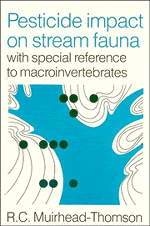Book contents
- Frontmatter
- Contents
- Preface and Acknowledgements
- PART I INTRODUCTION AND ORIGIN OF PESTICIDES IN RUNNING WATERS
- PART II THE ROLE OF LABORATORY AND EXPERIMENTAL METHODS IN EVALUATION
- PART III EVALUATION IN PEST CONTROL PROJECTS
- SIX Introduction to field sampling of aquatic macroinvertebrates in streams and rivers
- SEVEN Impact of insecticides used in control of the spruce budworm
- EIGHT Aquatic environmental effects of insecticides used in tsetse fly control
- NINE Effect on non-targets of larvicides applied to running waters for control of blackfly (Simulium) larvae
- TEN Impact of piscicides (and molluscicides)
- ELEVEN Herbicides and aquatic invertebrates
- Summary and assessment
- References
- Index
SIX - Introduction to field sampling of aquatic macroinvertebrates in streams and rivers
Published online by Cambridge University Press: 05 November 2011
- Frontmatter
- Contents
- Preface and Acknowledgements
- PART I INTRODUCTION AND ORIGIN OF PESTICIDES IN RUNNING WATERS
- PART II THE ROLE OF LABORATORY AND EXPERIMENTAL METHODS IN EVALUATION
- PART III EVALUATION IN PEST CONTROL PROJECTS
- SIX Introduction to field sampling of aquatic macroinvertebrates in streams and rivers
- SEVEN Impact of insecticides used in control of the spruce budworm
- EIGHT Aquatic environmental effects of insecticides used in tsetse fly control
- NINE Effect on non-targets of larvicides applied to running waters for control of blackfly (Simulium) larvae
- TEN Impact of piscicides (and molluscicides)
- ELEVEN Herbicides and aquatic invertebrates
- Summary and assessment
- References
- Index
Summary
INTRODUCTION
In Chapter 1 it was pointed out that many of the striking advances in knowledge over the last 10–15 years regarding pesticide impact have been the outcome of field studies in practical pest control programmes. In all these projects, the environmental studies relate to the known chemical and formulation which is either applied directly to the stream at a predetermined application rate calculated to produce the desired concentration of the chemical in the water, or which contaminates the stream indirectly as a result of aerial application of pesticide to control terrestrial pests in the environs of the stream or river, and where the dosage rate in terms of kilograms per hectare has again been predetermined. In both instances the actual time of application is also known precisely.
The object of these environmental studies is to find out the extent to which the pesticide treatment produces significant changes in the composition of stream fauna produced by mortality or downstream movement, with particular reference to the macroinvertebrates which are the subject of this review. In order to measure these effects and to ascertain significant population changes among the different organisms of running water community – both in the short term and the long term – pesticide ecologists have to rely on a variety of sampling methods. It is these various capture or trapping techniques which provide the essential data for measuring changes in population density or in population composition attributable to pesticide impact.
- Type
- Chapter
- Information
- Pesticide Impact on Stream FaunaWith Special Reference to Macroinvertebrates, pp. 119 - 127Publisher: Cambridge University PressPrint publication year: 1987



